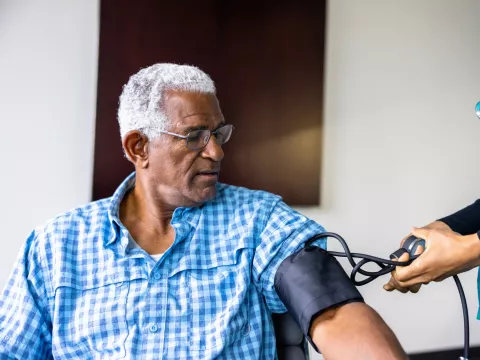- UChicago Medicine AdventHealth

About Cardiac Arrest
One of the leading causes of death in the United States, cardiac arrest can happen at any age and to either gender. Other celebrities who did not survive sudden cardiac arrest include musician Tom Petty, who died unexpectedly in 2017 at age 66; actor John Ritter, who was 54 when he suffered an aortic dissection that led to cardiac arrest in 2003; and child actress Heather O’Rourke, who was only 12 years old when her life was cut short by cardiac arrest in 1988.
What makes cardiac arrest so dangerous is the sudden and drastic nature of its effects. With only about an 8% survival rate for out-of-hospital cardiac arrest when treated by emergency services, quick medical attention is clearly required to survive.
Cardiac arrest is often confused as the same thing as a heart attack, but the two have key differences. Being able to identify cardiac arrest risk factors and early signs in yourself and your loved ones could help you save a life.
Cardiac Arrest vs. Heart Attack
Cardiac arrest occurs when the heart malfunctions and stops beating unexpectedly. It’s triggered by an electrical failure in the heart and causes an irregular heartbeat or arrhythmia. A person suffering from cardiac arrest may become unresponsive, is unable to breathe or is gasping for air. Symptoms include:
- Suddenly collapsing
- No breath
- No pulse
- Loss of consciousness
Some people have a heart attack with a blocked artery which results in cardiac arrest. Blood flow is not there; rhythm problems occur and the heart stops.
Heart attacks are one cause of cardiac arrest, but causes can also be familial or genetic. Even more rarely, they can be incidental. There are many causes of cardiac arrest, but the most common is heart attack.
In contrast, a heart attack occurs when blood flow to the heart is blocked. Unlike a cardiac arrest, heart attacks are a circulation or blood flow problem — the heart doesn’t actually stop — think of it as a mechanical rather than electrical problem. A blocked artery prevents blood from flowing freely to portions of the heart, and if blood isn’t able to reach that area after a period of time, the artery begins to die.
Heart attack symptoms include:
- Tightness, squeezing, pain or pressure in the chest/upper body (this feeling may go away and then come back)
- Shortness of breath
- Sweating/cold sweats
- Fatigue
- Trouble Sleeping
- Lightheadedness or dizziness
- Pain or discomfort in one or both arms, neck, jaw or stomach
- Nausea/vomiting
Most often, these symptoms are subtle and may go undetected as they creep up slowly, sometimes lasting for days or even weeks before the attack. Many people brush off symptoms as the flu, stress or simply feeling under the weather. Always seek help to be sure.
Not all heart attacks lead to cardiac arrest, generally, your survival rate long-term with a heart attack is about 97-98%; with cardiac arrest, your long-term survival rate is only about 50%.
Risk Factors
Cardiac arrest occurs in both children and adults, but much more commonly in adults. There can be several contributing factors to future cardiac arrest.
Factors include one's age, structural problems with the heart — young kids will sometimes have very thick hearts or hearts that are not well-developed that can make them predisposed to some electrical problems. Whether you're young or old, sometimes your heart is bigger, which can predispose you to electrical arrhythmias that lead to cardiac arrest.
If you've had a heart attack and a vessel or artery gets blocked off, a large part of the muscle can be dead or damaged which also increases the likelihood of an arrhythmia causing sudden death.
The most non-probable cause of sudden death from a heart attack in young people is having a blocked artery from plaque buildup, what most people think in traditional heart attacks.
Other more probable causes of heart attacks in younger people include:
- Undiagnosed cardiomyopathy or hypertrophic cardiomyopathy that can predispose a person to an enlarged heart or a thickening of the tissue that could lead to a sudden heart attack
- Congenital abnormalities of the arteries, where the arteries are not hooked up correctly and can compress and lead to sudden death
- Undiagnosed arrhythmogenic issues where there is an electrical issue in the heart that was unknown that could have led to a sudden heart attack and death
Adults should stay on top of their routine checkups and blood pressure levels to get ahead of potential arrhythmias. If a parent experiences a heart issue in their life, genetic tests can also be performed on their children to ensure their risk factors are caught early.
Don’t Hesitate to Seek Help
Early intervention is key to avoiding what might become deadly cardiac arrest. The earliest signs to look for might be things you can’t necessarily see or feel, like high blood pressure and diabetes, but also weight and previous health history. It's important to get your checkups, your bloodwork and your blood pressure done to look for any signs. If you control the risk factors, your outcome is much better.
Most cardiac arrests occur at home. Performing CPR or even just compressions to the chest can improve the chances of survival until emergency medical teams arrive.
If you suspect you or a loved one are having a heart attack or cardiac arrest, call 911. It’s best to call for emergency help than to risk underestimating your symptoms.
Click here to learn more about how we can help keep your heart healthy or request an appointment with a specialist.





